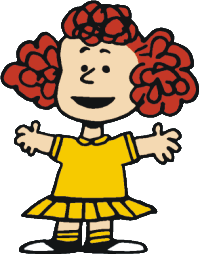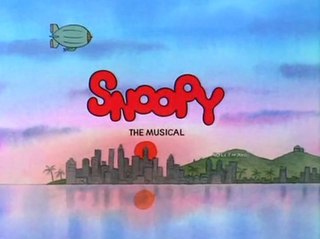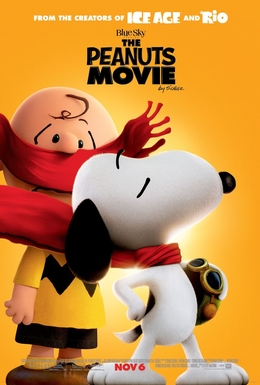
Charles Monroe "Sparky" Schulz was an American cartoonist, the creator of the comic strip Peanuts which features his two best-known characters, Charlie Brown and Snoopy. He is widely regarded as one of the most influential cartoonists in history, and cited by many cartoonists as a major influence, including Jim Davis, Murray Ball, Bill Watterson, Matt Groening, and Dav Pilkey.

Peanuts is a syndicated daily and Sunday American comic strip written and illustrated by Charles M. Schulz. The strip's original run extended from 1950 to 2000, continuing in reruns afterward. Peanuts is among the most popular and influential in the history of comic strips, with 17,897 strips published in all, making it "arguably the longest story ever told by one human being" and is considered to be the grandfather of slice of life cartoons. At the time of Schulz's death in 2000, Peanuts ran in over 2,600 newspapers, with a readership of around 355 million in 75 countries, and was translated into 21 languages. It helped to cement the four-panel gag strip as the standard in the United States, and together with its merchandise earned Schulz more than $1 billion.

It's the Great Pumpkin, Charlie Brown is a 1966 American animated Halloween television special based on the comic strip Peanuts by Charles M. Schulz. The third Peanuts special, and the second holiday-themed special, to be created, it was written by Schulz along with director/animator Bill Melendez and producer Lee Mendelson. The cast included Peter Robbins as Charlie Brown, Christopher Shea as Linus Van Pelt, Sally Dryer as Lucy Van Pelt, and Melendez as Snoopy. The special features music composed by jazz pianist Vince Guaraldi, whose contributions include the theme song "Linus and Lucy". It aired on broadcast television every year from its debut in 1966 until 2020 when it became an Apple TV+ exclusive.

Linus Van Pelt is a fictional character in Charles M. Schulz’s comic strip Peanuts. He is the best friend of Charlie Brown, the younger brother of Lucy Van Pelt, and the older brother of Rerun Van Pelt. His first appearance was on September 19, 1952, but he was not mentioned by name until three days later. He was first referred two months earlier, on July 14. Linus spoke his first words in 1954, the same year he was first shown with his security blanket. Linus is named after Schulz's friend Linus Maurer.

Peppermint Patty is a fictional character featured in Charles M. Schulz's comic strip Peanuts. Her full name, very rarely used in the strip, is Patricia Reichardt. She is one of a small group in the strip who live across town from Charlie Brown and his school friends. She has freckles and "mousy-blah" hair, and generally displays the characteristics of a tomboy, while also being shown to not be a strict complier. She made her first appearance on August 22, 1966. The following year she made her animated debut in the TV special You're in Love, Charlie Brown and began coaching a baseball team that played against Charlie Brown, and thereafter had other adventures with him. Uniquely, she refers to Charlie Brown and Lucy as "Chuck" and "Lucille", respectively. In most of her appearances, she is attracted to Charlie Brown, based on her reactions. Her birthday is October 4.

Rerun Van Pelt is Linus and Lucy's younger brother in Charles M. Schulz's comic strip Peanuts. Lucy Van Pelt, his sister, disparagingly calls the situation a "rerun" of the birth of her brother Linus, so Linus nicknames the child "Rerun". Despite Lucy's disappointment, she becomes a warm and protective older sister.

Shermy is a fictional character from the comic strip Peanuts, by Charles Schulz. Schulz named him after a friend from high school. When Peanuts made its debut on October 2, 1950, Shermy sat with another early character, Patty on the curb, and spoke the first lines of dialogue, ending with "Good ol' Charlie Brown...How I hate him!" which is ironic, considering how he became one of Charlie Brown's closest friends, along with Linus van Pelt and Schroeder.

Frieda is a fictional character in the comic strip Peanuts by Charles Schulz. She is known for having naturally curly hair, of which she is extremely proud.

Woodstock is a fictional character in Charles M. Schulz's comic strip Peanuts. He is a small yellow bird and Snoopy's best friend. The character first appeared in the April 4, 1967, strip, though he was not officially named until June 22, 1970. He is named after the Woodstock festival of 1969.

Snoopy, Come Home! is a 1972 American animated musical comedy-drama film directed by Bill Melendez and written by Charles M. Schulz based on the Peanuts comic strip. The film marks the on-screen debut of Woodstock, who had first appeared in the strip in 1967. It was the only Peanuts film during composer Vince Guaraldi’s lifetime that did not have a score composed by him. Its music was composed by the Sherman Brothers, who composed the music for various Disney films like Mary Poppins (1964), The Jungle Book (1967), and Bedknobs and Broomsticks (1971). The film was released on August 9, 1972 by National General Corporation, produced by Lee Mendelson Films, Bill Melendez Productions and Cinema Center Films. Despite receiving largely positive reviews, the film was a box-office flop, grossing only $245,073 against a production budget of over $1 million.

It's the Easter Beagle, Charlie Brown! is the 12th prime-time animated TV special based on the comic strip Peanuts by Charles M. Schulz. In the United States, it debuted on CBS on April 9, 1974 at 8 PM.

Life is a Circus, Charlie Brown is the 20th prime-time animated television special based upon the popular comic strip Peanuts, by Charles M. Schulz. It was originally aired on the CBS network on October 24, 1980. The special won an Emmy Award in 1981 for Outstanding Animated Program.

A Charlie Brown Celebration is the 23rd prime-time animated television special based upon the popular comic strip Peanuts, by Charles M. Schulz, who appears in a live-action prologue, and the first hour-long special. It was originally aired on the CBS network on May 24, 1982, and consists of a number of stories adapted from the comic strip.

Snoopy's Getting Married, Charlie Brown is the 28th prime-time animated television special based on the comic strip Peanuts by Charles M. Schulz. It was originally aired on the CBS network on March 20, 1985.

Snoopy's Reunion is the 34th prime-time animated TV special based upon the comic strip Peanuts, by Charles M. Schulz. It originally aired on the CBS network on May 1, 1991 as part of the animated anthology series Toon Nite. It is one of three Peanuts projects to date not to have "Charlie Brown" in the title and one of the few Peanuts specials to feature adults on-screen.

I Want a Dog for Christmas, Charlie Brown is the 43rd prime-time animated television special based upon the popular comic strip Peanuts by Charles M. Schulz. The special first aired on ABC on December 9, 2003. The special is about Linus and Lucy's younger brother, Rerun, wanting a pet dog for Christmas.

It's the Pied Piper, Charlie Brown is the 39th and last animated special produced under the supervision of Charles M. Schulz. Based on characters from the comic strip Peanuts, it was originally released exclusively in VHS and DVD formats on September 12, 2000, seven months after Schulz's death.

Snoopy! The Musical is the 31st prime-time animated TV special, based on characters from the Charles M. Schulz comic strip Peanuts. It is an animated adaptation of the musical of the same name, and originally aired on the CBS network on January 29, 1988.

The Peanuts Movie is a 2015 American animated comedy film based on Charles M. Schulz's comic strip Peanuts, produced by Blue Sky Studios and distributed by 20th Century Fox. It is the fifth full-length Peanuts film and the first in 35 years. The film was directed by Steve Martino from a screenplay by Cornelius Uliano and Craig and Bryan Schulz. Uliano and the Schulzes also serve as producers alongside Paul Feig and Michael J. Travers. The film stars the voices of Noah Schnapp as Charlie Brown and, via archival recordings, Bill Melendez as Snoopy and Woodstock, alongside the ensemble voices of Hadley Belle Miller, Mariel Sheets, Alex Garfin, Francesca Angelucci Capaldi, Venus Omega Schultheis, Rebecca Bloom, Marelik "Mar Mar" Walker, Noah Johnston, Anastasia Bredikhina, Madisyn Shipman, AJ Teece, Troy "Trombone Shorty" Andrews, and Kristin Chenoweth. The film sees Charlie Brown trying to improve his odds with the Little Red-Haired Girl, while Snoopy writes a book where he is a World War I Flying Ace trying to save his fellow pilot and love interest Fifi from the Red Baron and his flying circus.























